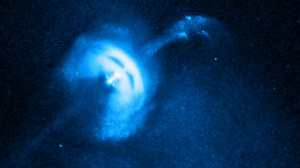Charged particles travel faster than light through the quantum vacuum of space that surrounds pulsars. As these electrons and protons fly by pulsars, they create the ultrabright gamma-ray flashes emitted by the rapidly twirling neutron stars, new research reveals.
These gamma-rays, called Cherenkov emissions, are also found in powerful particle accelerators on Earth, such as the Large Hadron Collider near Geneva, Switzerland. The rays are also the source of the bluish-white glow in the waters of a nuclear reactor.
But until now, no one thought that pulsar emissions consisted of Cherenkov radiation.
That’s in part because of Albert Einstein’s famous theory of relativity, which holds that nothing can travel faster than light in a vacuum. Because of those propositions, scientists previously thought that Cherenkov emissions couldn’t happen in the quantum vacuum of space surrounding pulsars. That area is mostly devoid of matter but home to ghostly quantum particles that flicker in and out of existence.
Read more HERE
Ask me anything
Explore related questions





